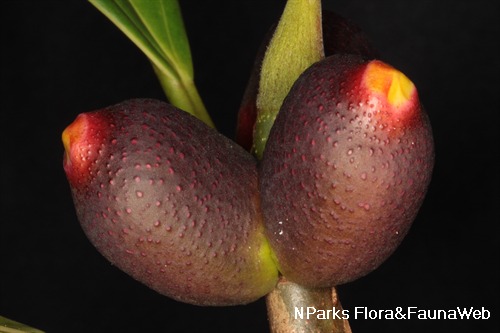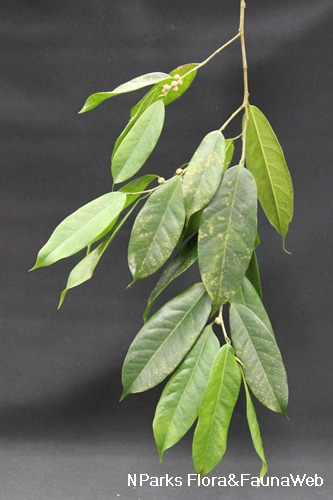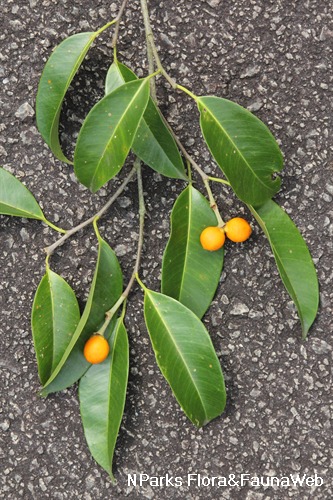
Name
Classifications and Characteristics
| Plant Division | Angiosperms (Flowering Seed Plants) (Dicotyledon) |
|---|---|
| Plant Growth Form | Tree (Medium (16m-30m)) |
| Lifespan (in Singapore) | Perennial |
| Mode of Nutrition | Autotrophic |
| Plant Shape | Irregular |
Biogeography
| Native Distribution | Laos, Thailand, Sumatra, Peninsular Malaysia, Singapore, and Borneo |
|---|---|
| Native Habitat | Terrestrial (Primary Rainforest, Secondary Rainforest) |
| Preferred Climate Zone | Tropical |
| Local Conservation Status | Native to Singapore (Critically Endangered (CR)) |
Description and Ethnobotany
| Growth Form | It is a latex-containing, strangling fig that eventually becomes a small to medium-sized tree up to 30 m tall. |
|---|---|
| Foliage | Its spirally arranged, long-stalked leaves have thickly leathery leaf blades that are usually drop-shaped, cardboard-like, 13–35 by 6–17 cm, and yellowish-brown above when dried. |
| Flowers | The plant is monoecious. Its male, female and gall flowers are found within the same syconium (fig). The flowers are tiny and develop within the syconium (fig). |
| Fruit | Its stalkless syconia (figs) are usually oblong, up to 3.5 cm wide, orange then purplish-red when ripe, and occur singly or in pairs. |
| Habitat | It grows in lowland forests, and on nutrient-poor soil. |
| Associated Fauna | Its flowers are pollinated by fig wasps. The ripe fruits are probably eaten by frugivorous mammals. |
| Cultivation | It can be propagated by seed, stem cutting or air-layering. |
| Etymology | Latin Ficus, the commercial edible fig (Ficus carica); Greek xylon, wood; Greek phullon, leaf, referring to the thick, cardboard-like leaves |
Landscaping Features
| Landscaping | Its leaves and bright-coloured figs are attractive. It is suitable for gardens and parks. |
|---|---|
| Desirable Plant Features | Ornamental Foliage, Ornamental Fruits |
| Landscape Uses | General, Parks & Gardens, Small Gardens |
Fauna, Pollination and Dispersal
| Pollination Method(s) | Biotic (Fauna) (Insects (Ant, Beetle, Fly, Thrip, Wasp)) |
|---|---|
| Seed or Spore Dispersal | Biotic (Fauna) (Vertebrates (Other Mammal)) |
Plant Care and Propagation
| Light Preference | Full Sun, Semi-Shade |
|---|---|
| Water Preference | Moderate Water |
| Plant Growth Rate | Moderate |
| Rootzone Tolerance | Moist Soils, Well-Drained Soils, Poor Infertile Soils |
| Propagation Method | Seed, Stem Cutting |
Foliar
| Foliage Retention | Evergreen |
|---|---|
| Mature Foliage Colour(s) | Green |
| Mature Foliage Texture(s) | Leathery, Thick |
| Foliar Type | Simple / Unifoliate |
| Foliar Arrangement Along Stem | Alternate |
| Foliar Attachment to Stem | Petiolate |
| Foliar Shape(s) | Non-Palm Foliage (Obovate) |
| Foliar Venation | Pinnate / Net |
| Foliar Margin | Entire |
| Foliar Apex - Tip | Rounded |
| Foliar Base | Cuneate |
Non - Foliar and Storage
| Trunk Type (Non Palm) | Woody |
|---|---|
| Root Type | Underground, Aboveground (Strangling Root) |
Floral (Angiosperm)
| Flower & Plant Sexuality | Unisexual Flowers , Monoecious |
| Flower Grouping | Cluster / Inflorescence |
|---|
| Flower Location | Axillary |
| Inflorescence Type | Syconium |
Fruit, Seed and Spore
| Mature Fruit Colour(s) | Orange, Purple |
|---|---|
| Fruit Classification | Multiple Fruit |
| Fruit Type | Fleshy Fruit , Accessory / False Fruit (Pseudocarp) |
Image Repository
Others
| Master ID | 31200 |
|---|---|
| Species ID | 5594 |
| Flora Disclaimer | The information in this website has been compiled from reliable sources, such as reference works on medicinal plants. It is not a substitute for medical advice or treatment and NParks does not purport to provide any medical advice. Readers should always consult his/her physician before using or consuming a plant for medicinal purposes. |









.jpg)
